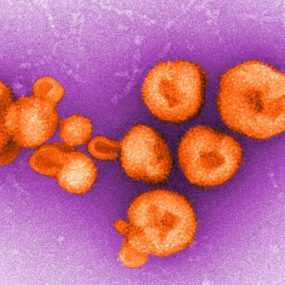Arenaviridae
The Arenaviridae are a family of viruses whose members are generally associated with rodent-transmitted diseases in humans. Each virus usually is associated with a particular rodent host species in which it is maintained. Arenavirus infections are relatively common in humans in some areas of the world and can cause severe illnesses.
The virus particles are spherical and have an average diameter of 110-130 nanometers. All are enveloped in a lipid (fat) membrane. Viewed in cross-section, they show grainy particles that are ribosomes acquired from their host cells. It is this characteristic that gave them their name, derived from the Latin “arena”, which means “sandy”. Their genome, or genetic material, is composed of RNA only, and while their replication strategy is not completely understood, we know that new viral particles, called virions, are created by budding from the surface of their hosts’ cells.
Arenavirus history
The first Arenavirus, Lymphocytic choriomeningitis virus (LCMV), was isolated in 1933 during a study of an epidemic of St. Louis encephalitis. Although not the cause of the outbreak, LCMV was found to be a cause of aseptic (nonbacterial) meningitis. By the 1960s, several similar viruses had been discovered and they were classified into the new family Arenaviridae. Since Tacaribe virus was found in 1956, new Arenavirus have been discovered on the average of every one to three years. A number of Arenavirus have been isolated in rodents only, but few cause hemorrhagic disease. Junin virus, isolated in 1958, was the first of these to be recognized. This virus causes Argentine hemorrhagic fever in a limited agrigultural area of the pampas in Argentina. Several years later, in 1963, in the remote savannas of the Beni province of Bolivia, Machupo virus was isolated. The next member of the virus family to be associated with an outbreak of human illness was Lassa virus in Nigeria in 1969. The most recent additions to these human pathogenic viruses were Guanarito detected in Venezuela in 1989, Sabia in Brazil in 1993, Chapare in Bolivia in 2004, and Lujo in South Africa in 2008.

Arenaviruses groups
Arenavirus are divided into two groups: the New World or Tacaribe complex and the Old World or LCM/Lassa complex. Viruses in these groups that cause mild or severe illness in humans and are listed below by date of discovery:
| Virus | Disease | Year discovered |
|---|---|---|
| Lymphocytic choriomeningitis virus (LCMV) | Lymphocytic choriomeningitis | 1933 |
| Junin virus | Argentine hemorrhagic fever | 1958 |
| Machupo virus | Bolivian hemorrhagic fever | 1963 |
| Lassa virus | Lassa fever | 1969 |
| Guanarito virus | Venezuelan hemorrhagic fever | 1989 |
| Sabia | Brazilian hemorrhagic fever | 1993 |
| Chapare | Chapare hemorrhagic fever | 2004 |
| Lujo | Lujo hemorrhagic fever | 2008 |
Animal hosts
These viruses are zoonotic, meaning that, in nature, they are found in animals. Each virus is associated with either one species or a few closely related rodents, which constitute the virus’ natural reservoir. Tacaribe complex viruses are generally associated with the New World rats and mice (family Muridae, subfamily Sigmodontinae). The LCM/Lassa complex viruses are associated with the Old World rats and mice (family Muridae, subfamily Murinae). Taken together, these types of rodents are located across the greater proportion of the earth’s land mass, including Europe, Asia, Africa, and the Americas. One notable exception is Tacaribe virus, found in Trinidad, which was isolated from bats and mosquitoes.
Spreading Arenavirus infections
The rodent hosts of Arenavirus species are chronically infected with virus; however, the viruses do not appear to cause obvious illness in them. Some Arenavirus types appear to be passed from mother rodents to their offspring during pregnancy, and thus remain in the rodent population generation after generation. Most infections are transmitted among adult rodents, likely via fighting and inflicting bites. Only a portion of the rodents in each host species is infected at any one time, and in many cases only in a limited portion of the host’s geographical range. Viruses are shed into the environment in the urine or droppings of the infected hosts.
Human infection with an Arenavirus is incidental to the natural cycle of the viruses and occurs when an individual comes into contact with the excretions or materials contaminated with the excretions of an infected rodent, such as ingestion of contaminated food, or by direct contact of abraded or broken skin with rodent excrement. Infection can also occur by inhalation of tiny particles soiled with rodent urine or saliva (aerosol transmission). The types of incidental contact depend on the habits of both humans and rodents. For example, where the infected rodent species prefers a field habitat, human infection is associated with agricultural work. In areas where the rodent species’ habitat includes human homes or other buildings, infection occurs in domestic settings.
Some Arenaviruses, such as Lassa, Machupo, and Lujo viruses, are associated with secondary person-to-person and nosocomial (healthcare setting) transmission. This occurs when a person infected by exposure to the virus from the rodent host spreads the virus to other humans. This may occur in a variety of ways. Person-to-person transmission is associated with direct contact with the blood or other body fluids, containing virus particles, of infected individuals. Airborne transmission has also been reported in connection with certain viruses. Contact with objects contaminated with these materials, such as medical equipment, is also associated with transmission. In these situations, use of protective clothing and disinfection procedures (together called barrier nursing) help prevent further spread of illness.
- Page last reviewed: June 18, 2013
- Page last updated: June 18, 2013
- Content source:


 ShareCompartir
ShareCompartir